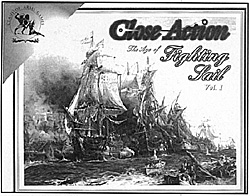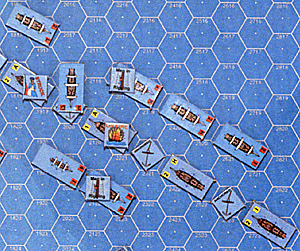 Game Design: Mark A. Campbell
Game Design: Mark A. Campbell
Game Graphics: Steve
Pancrazio
Number of Players: 2-
18 or more
Playing Time: One
to eight hours
Complexity Level:
Moderately low
Scale:
Tactical; one ship per counter, 67.5 yards
per hex, 200 seconds per turn.
Maps & Playing Pieces: Units
are ships, accruing damage to rigging, hull,
crew, and guns using a graphic roster
system. Cardboard ship counters
maneuver in six directions on two 22-inch-
by-34-inch mapsheets of 5/8-inch hexagons.
Rules: 44-page softbound
book with table of contents and glossary
plus 48-page softbound Scenario Book
with substantial historical information and
critical bibliography.
Scenarios: 25 mainly historical
scenarios plus one hypothetical variant.
Publisher: Clash of Arms Games
Publication Date: 1997
List Price: $44.00
Summary: Close Action
is a highly realistic, easy-to-teach game of
late 18th to early 19th Century naval
battles. It recreates single-ship
engagements well, multi-player squadron
and fleet actions superlatively. The large
number of scenarios plus design-your-own
data provide a high replay value.
Clash of Arms' Close Action is an excellent two- or multi-player game recreating sailing ship actions of the French Revolutionary and Napoleonic Wars. Each player commands one or more ships ranging from 14-gun corvettes to 120-gun ships of the line. Each ship is rated for size, speed, and maneuverability, and incurs damage to rigging, hull, crew, and guns using a roster system. For each ship, a player must plot the turn's movement in advance, allocate the crew among a number of possible tasks, and choose a target for the ship's guns. Players then simultaneously move and resolve combat.
25 scenarios are included with the game, ranging from singleship frigate duels to Nelson's destruction of the French fleet in 1798 at the Battle of the Nile (plus a hypothetical encounter between the two fleets at sea prior to the historical engagement). Not all scenarios are balanced, although carefully crafted victory conditions usually allow both sides an opportunity to avoid defeat. Based solely on the forces involved and using the game's scale of victory points, seven of the 26 scenarios are fairly evenly matched, and in six scenarios the larger force is only 10-15% superior (the smaller force won half of these battles historically). In the remaining thirteen engagements, the larger force has a greater than 15% advantage and won historically all but once.
Close Action can accommodate a range of from two to 23 players, and even larger battles have been run well at conventions with an experienced gamemaster. The beauty of the system is that only a few experienced players are needed for everyone to enjoy the contest, since less than 15 minutes suffice to explain the basics of the game and get the action underway.
Single-ship actions are satisfactory, particularly with the optional impulse movement rules, but are best as a learning tool to gain familiarity with the rules. Not surprisingly, a Close Action battle with only two or three ships shares the shortcoming common to all turn-based games in which moves are plotted: it becomes a guessing game more than a tactical contest. Fortunately, this drawback becomes a dramatic advantage when each side has two or more players, because now players are uncertain what their own teammates are doing and must strive to synchronize their movements - and avoid colliding with one another! - despite very limited communication. This game positively shines in multi-ship actions when each player controls one or at most two ships, and players soon appreciate the discipline and teamwork necessary to maneuver a formation of sailing vessels without radios to aid in coordination.
The sequence of play and basic mechanics of movement will be very familiar to players of the Avalon Hill Game Company's classic Wooden Ships and Iron Men. Each player secretly plots the movement of his or her ship(s) for the turn, after which all movement is executed simultaneously. Ships move only along the hex grain and pivot around their bows to turn. All ships may point 60 degrees into the wind - fore-andaft rigged vessels are not represented and must move at least one hex straight ahead in between 60- degree turns, varying with speed and maneuverability. Alternate turns in opposite directions (i.e., first port, then starboard) sometimes require fewer hexes of straight movement in between to reflect the effect of actually steering a course in between 60-degree angles. Wind strength, hull type, damage, and facing relative to the wind determine maximum speed; acceleration and deceleration are limited. Probably the biggest improvement over other games is that tacking (turning the bow of a sailing ship into and through the wind) is never a sure thing, and the chance of success is greatly influenced by damage and crew quality All of this requires only nine pages of rules to codify -- including eight diagrams and no less than 52 examples of play! The rules are thorough rather than complex. Time is invested in annotating the correct movement allowance information on each ship's roster sheet before the game rather than in consulting charts during play, so movement procedures are easily explained to a novice and turns proceed swiftly.
Similarly, players must spend some time before the game determining basic gunnery numbers at each range from 1 to 15 hexes for their ships, and annotating their roster sheets with the correct amount of rigging, hull, and crew damage boxes. A well-thought out sample roster sheet aids in illustrating how this is done, and supplements many of the examples of play embedded in the rules. The end result is a gunnery and damage system which is simple and relatively quick to execute while still highly realistic.
To fire during a turn, the basic gunnery number is modified for crew quality and casualties, gun losses, and a few other uncommon factors, and a single die is rolled for each ship. The result is read on a simple chart, which may require one or more additional rolls to determine the possibility of further damage (critical hits). After a game or two, this becomes very natural, and a whole squadron's gunfire can be resolved in a couple of minutes.
The greatest feature aiding realism in Close Action is the limitation placed on a ship's crew. Every crew is divided into five sections, and each sectiori can only perform one of a number of tasks each turn: loading and firing a broadside, changing sail, tacking, making repairs, fighting a fire, and so forth. Some tasks require more than one section, and if fewer than the optimal number of men are allocated, the task takes longer to accomplish or is less likely to be completed. Many tasks always require more than one turn, and players are constantly challenged to make the best use of their sailors and marines.
Boarding is an example of this procedure. Before conducting a boarding attack, a ship must spend a turn preparing boarders. This reflects the time required to muster the designated crewmen on deck and distribute their weapons, time when they can not be firing the ship's guns or blazing away with muskets at an enemy alongside. Together with the likelihood of heavy casualties and a limited chance of success, this has the effect of making boarding actions much less common than in most games on this subject, and much less likely to prove decisive when they do occur.
As already mentioned, crew quality has an impact on virtually every action a ship attempts. Crews are initially rated from "A" (best) to "E" (worst). Besides this initial quality rating, however, crews also have a morale rating. Ships seldom continue fighting until they sink. Instead, failure of morale checks which force the quality level to decrease below "G" will cause a ship to "strike" its colors (surrender).
Besides the basics of moving and fighting a ship, the comprehensive ruies include procedures for towing, anchoring, and shallow water operations, none of which are needed in most scenarios. Signaling rules are also included, because Close Action is intended to be a multi- player game which best simulates squadron and fleet actions. Overall, the rules are carefully crafted, logically arranged, and virtually error-free.
Other welcome features of the rules include extensive historical background for each scenario and cogent designer's notes. Best of all, however, are the three pages of critical bibliography - a valuable source guide for even serious students of 18th and 19th Century naval warfare. Designer Mark Campbell has been developing this game continuously for over 15 years, and his care and attention to detail show clearly. A campaign game is presently undergoing playtesting, and hopefully Clash of Arms will publish sequels to this game, which is subtitled "The Age of Fighting Sail Vol. I" Close Action is also ideally suited for play-by-e-mail (PBEM) contests involving several participants and a referee. Designer Mark Campbell and others are running PBEM games, and an address is provided in the game for those interested.
As far as the game's physical components, the box cover art is superb, but other elements tend to favor functionality over aesthetics. The two mapsheets are simple, consisting of a white hex grid and black directional compass overlaid upon four shades of blue (arranged to represent depth contours or land where required for a few scenarios). One sheet contains three errors (a mislabeled compass, a slightly misdrawn depth contour, and one contour band entirely missing), but all are covered in included errata and none are critical to play. 70 one-inch by half-inch ship counters depict four classes of ships for two forces, generically lettered rather than named.
These counters are two-sided to represent the two most commonly used of the four possible sail states in the game, and for unknown reasons are printed in opposite directions, which causes players the minor annoyance of having to rotate them 180' as well as flip them when changing states. An additional 140 half- inch square counters provide markers for other sail states, grappling, anchoring, fires, and a number of other functions. All counters are of medium-thickness cardboard in two sheets, with superior die cutting.
Despite the wealth of detail and high standards of accuracy incorporated into Close Action, Mark Campbell and Clash of Arms have succeeded in producing a game which is mechanically simple and relatively fast-moving. Through skillful use of player-aid charts and well- designed ship logs, what tedious work is required is completed prior to actually beginning a game. This leaves players free to concentrate upon maneuvering and fighting their ships without having to constantly consult charts or the rule book. If you are looking for the best meld of historical realism and playability in a multi-player game, Close Action is a good bet.
Battle of the Nile
Part of a representation of Nelson's and Brueys' battle lines in Aboukir Bay using the counters and map from Close Action by Clash of Arms Games. The French flagship Orient is on fire while Franklin and Peuple Souverain have both "struck" (surrendered).

Back to Table of Contents -- Napoleon #13
Back to Napoleon List of Issues
Back to MagWeb Master Magazine List
© Copyright 1998 by Napoleon LLC.
This article appears in MagWeb (Magazine Web) on the Internet World Wide Web.
The full text and graphics from other military history magazines and gaming magazines are available at http://www.magweb.com
Order Napoleon magazine direct